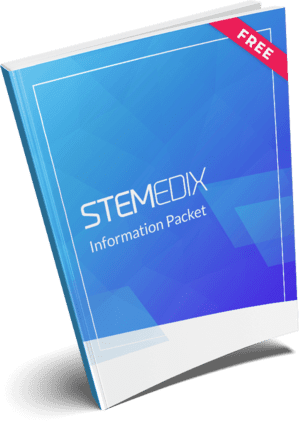Chronic back pain is one of the most common health complaints worldwide, especially among older adults. As the population continues to age, spinal conditions such as intervertebral disc degeneration (IDD) are becoming increasingly common. These conditions not only cause physical discomfort but also impact mental well-being, reduce mobility, and lead to increased healthcare costs.
Researchers are exploring innovative solutions to slow or even reverse spinal degeneration. Among the most promising developments is stem cell therapy. This approach aims to restore the health and function of spinal discs using the body’s own regenerative capabilities. As scientists uncover more about the biology of the spine and the potential of stem cells, new opportunities for long-lasting relief are emerging.
In this review, Zhang et al. summarize and analyse the current evidence on stem cell therapy for IDD.
Understanding the Structure and Function of the Intervertebral Disc
The spine is made up of vertebrae separated by intervertebral discs. These discs function as cushions that absorb shock and help the spine move flexibly. Each disc consists of three main parts: the nucleus pulposus (NP) at the center, the surrounding annulus fibrosus (AF), and the cartilaginous endplates (CEPs) on the top and bottom.
The NP is rich in water and proteoglycans, which help it resist compression. It is surrounded by the AF, a tough, layered ring of collagen fibers that provides structural stability. The CEPs connect the discs to the vertebrae and allow for nutrient exchange between blood vessels and the largely avascular disc.
When these structures begin to deteriorate, the disc loses its ability to support and cushion the spine. This breakdown is known as intervertebral disc degeneration. Over time, the disc becomes dehydrated, the structure weakens, and inflammation increases. These changes can compress nearby nerves, leading to pain, stiffness, and limited movement.
The Degenerative Process and Its Impact on the Spine
IDD can begin as early as a person’s 20s, but it becomes much more common with age. As NP cells decline and the extracellular matrix (ECM) breaks down, the disc’s water content decreases. This causes the disc to shrink and stiffen, altering spinal mechanics and leading to a chain reaction of damage in surrounding structures.
Inflammation plays a major role in disc degeneration. Pro-inflammatory cytokines such as interleukins (IL-1, IL-6, IL-8) and tumor necrosis factor-alpha (TNF-α) promote the production of enzymes that degrade the ECM. These cytokines reduce the synthesis of proteoglycans, weaken the disc’s ability to absorb shock, and increase pain.
In advanced stages of IDD, the disc may bulge or herniate, pressing against spinal nerves and causing chronic back pain, sciatica, or even more serious complications like spinal stenosis. Because the disc has limited blood supply, its capacity for self-repair is minimal. Traditional treatments often focus only on symptom relief rather than restoring disc health.
Current Approaches and Their Limitations
Conventional treatments for IDD range from physical therapy and anti-inflammatory medications to steroid injections and, in severe cases, surgery. These methods may provide short-term relief but do not address the underlying causes of disc degeneration.
Surgical options such as spinal fusion or disc replacement may stabilize the spine or remove damaged tissue, but they come with risks such as infection, nerve injury, or limited mobility. Surgery also does not regenerate the disc or replace lost NP cells. Because of these limitations, there is growing interest in regenerative therapies that aim to heal the disc itself.
The Promise of Stem Cell Therapy
Stem cells are capable of transforming into many different cell types, including those needed for disc repair. They also release signaling molecules that help reduce inflammation, promote healing, and support tissue regeneration.
Several types of stem cells are currently being explored for IDD treatment. Mesenchymal stem cells (MSCs) are the most commonly used and can be derived from bone marrow, adipose (fat) tissue, or umbilical cord tissue. These cells have shown promise in preclinical studies for their ability to differentiate into NP-like cells, restore disc structure, and improve spinal function.
Other stem cell types include intervertebral disc-derived stem cells (such as NP stem cells and AF stem cells) and pluripotent stem cells like embryonic stem cells (ESCs) or induced pluripotent stem cells (iPSCs). While these cells have potential, their use is often limited by ethical concerns, tumorigenic risks, or complex handling requirements.
Supporting Evidence from Laboratory, Animal, and Clinical Studies
Laboratory and animal studies have provided strong evidence that stem cells can help repair degenerated discs. In animal models, stem cell injections have been shown to reduce inflammation, restore disc height, and increase ECM production. Some early clinical trials in humans have also reported improvements in back pain and disc structure after stem cell treatment.
However, outcomes vary depending on the cell type, delivery method, and patient characteristics. In some studies, high doses of injected cells caused adverse effects, including inflammation or unintended cell migration. Clinical trials with hematopoietic stem cells (HSCs), for example, showed positive effects in animals but limited benefit in human patients.
Overall, while the potential is clear, the authors call for more standardized protocols and long-term data to confirm the safety and effectiveness of stem cell therapies for IDD.
Challenges and Considerations in Cell Delivery
One of the major challenges in applying stem cell therapy for IDD is delivering the cells safely and effectively into the disc space. Improper injection techniques can damage the disc or lead to infection. Moreover, the harsh, low-oxygen environment inside degenerated discs can limit stem cell survival.
Another concern is cell leakage. Without a reliable carrier, injected stem cells may migrate away from the target area, reducing their therapeutic benefit or even causing side effects like bone spur formation. To overcome these obstacles, researchers are developing advanced scaffolds and carriers to contain the cells and control their release.
These carriers are typically made from biocompatible materials like hydrogels or microcapsules. They not only help anchor the cells in place but also create a supportive environment for them to survive, proliferate, and differentiate into NP-like cells. Carriers can also be combined with growth factors like TGF-β3 to enhance stem cell activity and ECM production.
The Role of Co-Culture Systems and Nanomaterials
Scientists are also exploring the use of co-culture systems—growing stem cells alongside other cell types to promote more natural interactions. For example, bone marrow-derived MSCs co-cultured with chondrocytes or NP cells have shown increased production of collagen and proteoglycans, both critical for disc structure and function.
Nanotechnology is playing a growing role as well. Self-assembling peptide nanofibers and other nanoscale scaffolds can guide stem cells to migrate, attach, and differentiate in precise ways. These materials help mimic the native environment of the disc, encouraging more effective regeneration.
Recent experiments in animal models using these technologies have demonstrated promising results in disc repair, including restored disc height and improved spinal biomechanics.
Drug Delivery Strategies to Enhance Stem Cell Function
In addition to using carriers and scaffolds, researchers are incorporating drug delivery systems into stem cell therapy. By loading therapeutic agents—such as growth factors or signaling molecules—into nanoparticles, scientists can influence stem cell behavior more precisely.
For example, studies have shown that loading albumin/heparin nanoparticles with the molecule SDF-1α and injecting them into degenerated discs enhances the ability of MSCs to home in on the disc, survive, and begin the repair process. These combined strategies are shaping the next generation of regenerative therapies for IDD.
Future Outlook for Stem Cell Therapy in Disc Degeneration
Stem cell therapy represents one of the most exciting developments in the treatment of intervertebral disc degeneration. Unlike current treatments that only relieve symptoms, stem cell approaches offer the possibility of regenerating damaged discs and restoring spine health at its source.
Efforts are currently underway to refine the technology, optimize cell carriers, and develop safer, more reliable delivery methods. The ability to tailor stem cell treatments to individual patients—through personalized medicine—may further enhance the effectiveness of these therapies.
Source: Zhang, W., Sun, T., Li, Y. et al. Application of stem cells in the repair of intervertebral disc degeneration. Stem Cell Res Ther 13, 70 (2022). https://doi.org/10.1186/s13287-022-02745-y


 St. Petersburg, Florida
St. Petersburg, Florida
